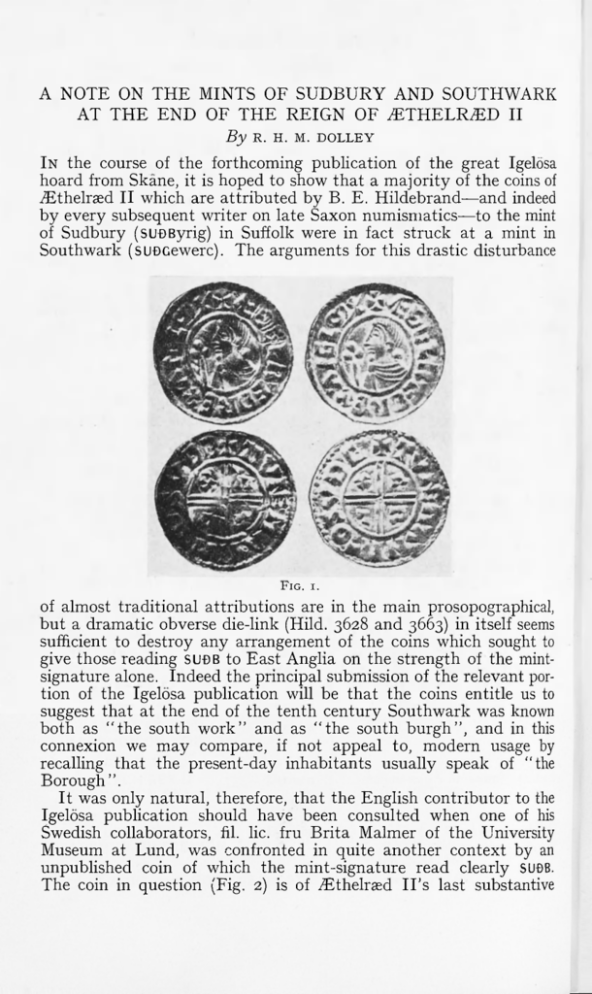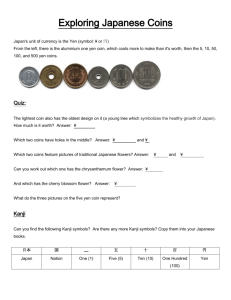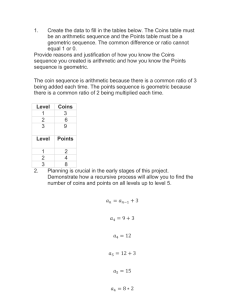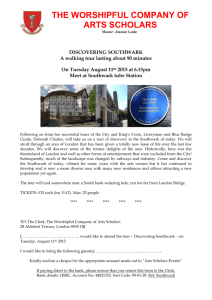A NOTE ON THE MINTS OF SUDBURY AND SOUTHWARK AT THE
advertisement

A N O T E ON T H E MINTS OF S U D B U R Y A N D S O U T H W A R K A T T H E E N D OF T H E R E I G N O F yETHELRTED II By R. H. M. DOLLEY IN the course of the forthcoming publication of the great Igelosa hoard from Skane, it is hoped to show that a majority of the coins of iEthelraed II which are attributed b y B. E. Hildebrand—and indeed by every subsequent writer on late Saxon numismatics—to the mint of Sudbury (SUBByrig) in Suffolk were in fact struck at a mint in Southwark (suecewerc). The arguments for this drastic disturbance FIG. I. of almost traditional attributions are in the main prosopographical, but a dramatic obverse die-link (Hild. 3628 and 3663) in itself seems sufficient to destroy any arrangement of the coins which sought to give those reading SU-BB to East Anglia on the strength of the mintsignature alone. Indeed the principal submission of the relevant portion of the Igelosa publication will be that the coins entitle us to suggest that at the end of the tenth century Southwark was known both as " t h e south w o r k " and as " t h e south burgh", and in this connexion we may compare, if not appeal to, modern usage by recalling that the present-day inhabitants usually speak of "the Borough". It was only natural, therefore, that the English contributor to the Igelosa publication should have been consulted when one of his Swedish collaborators, fil. lie. fru Brita Maimer of the University Museum at Lund, was confronted in quite another context by an unpublished coin of which the mint-signature read clearly sufiB. The coin in question (Fig. 2) is of ^Ethelraed II's last substantive A Note on the Mints of Sudbury and Southwark 265 issue, the so-called Last Small Cross type (Hildebrand Type A = Brooke Type 1 = B.M.C. Type I = Hawkins 205) which is believed to have been current from September ioog at least until the end of 1016. The moneyer is a certain Brantinc considered by Hildebrand to have been a moneyer of Southwark, though in point of fact not one of the three coins recorded in the 1881 edition of Anglosachsiska Mynt F I G . 2. reads at greater length than SUB. Brooke, it is interesting to note, assigned Brantinc to Sudbury, but unfortunately without giving his reasons. It is possible that he had seen a SU-BB coin—as we shall see, at least two pairs of dies are known with the fuller reading—but one is inclined to think that he may have been influenced by the fact that he knew Brantinc at Ipswich under Cnut. 1 The new coin occurred in a group from Gratrask in Norrbotten in Northern Sweden which represents individual offerings made at a pagan sanctuary by the Lapps in the early Middle Ages. These ex voto deposits, by no means confined to coins, have recently been made the subject of an exhaustive study by Dr. Inga Serning of Kiruna entitled Lapska Offerplatsfynd fran Jarnalder och Medeltid,2 to which there is appended a detailed list and discussion of the Kufic, German, English, and Scandinavian coins, the work respectively of fil. kand. fru LTlla S. Linder Welin, Dr. Vera Jammer (now Dr. Vera Hatz), Mrs. Maimer, and forste antikvarie Dr. Nils Ludwig Rasmusson. The purely numismatic sections of this work comprise more than thirty closely printed pages together with five excellent plates, and the thesis as a whole is one that deserves a place on the shelves of every serious student of medieval numismatics. Mrs. Maimer's own inclination was to reject Hildebrand's attribution in favour of Brooke's, and the present writer must confess to 1 The writer has been unable to trace the coin in question. 2 Uppsala, 1956. A Note on the Mints of Sudbury and Southwark 266 having instinctively endorsed this provisional decision. This was despite the fact that he himself had been the first to argue that in the Crux type of TEthelraed II the mint-signature SUOB was quite ambiguous, and in point of fact would seem more often than not to have denoted Southwark. The purpose of the present note is to suggest that there is new evidence to justify this seeming inconsistency, and that the endorsement of Mrs. Maimer's reattribution is not quite so capricious as might at first sight appear. In the first place we must not lose sight of the fact that between 997 when the Crux type ceased to be current and 1009, which is the earliest possible date for the coins of the Brantinc who concerns us here, there occurred sweeping and fundamental changes in the organization responsible for the supply of dies to the eighty-odd mints. While certainty is impossible pending a minute examination of the type as a whole, there is good reason to believe that most if not all of the dies for the Crux coinage were supplied from a single centre. In contrast a current paper has demonstrated that, in the Last Small Cross type, there are positive indications that the dies were distributed from a number of centres, each with its own engraver. 1 Consequently arguments that were valid in a discussion of the problem of Sudbury and Southwark as regards the Crux type by no means continue necessarily to hold good for an analysis of the position at the end of TEthelraed's reign. The all-critical Tuneman die-link, in fact, is not strictly relevant to the problem of Brantinc. The name Brantinc or Branting is one that is extremely rarely met with on late Saxon coins. Between 979 and 985 a Brantinc was operating at Ipswich, and between 979 and 991 we find a moneyer of the same name at Norwich. It is hard to avoid the conclusion that they are one and the same man. A t least eighteen years later we have another Brantinc, very probably a grandson, striking coins with the mint-signatures s u e and SUf)B, and he continues a short way into the reign of Cnut. It is difficult not to associate him with Brooke's Ipswich moneyer of the same name, and in this case there would seem to have been no more than two Brantincs in the late Saxon period, both in East Anglia where the name is far from being incongruous. An apparent exception is afforded by a coin which Hildebrand attributes to Lincoln (Fig. 4), but, as we shall see, the mint-reading is not 0 LIN but ON 5. 2 Prosopographically then a prima facie case can be made out for regarding Brantinc as a Sudbury and not a Southwark moneyer, the more so because he is not found striking at London. Hildebrand assigns no Last Small Cross coins to Sudbury, and it could be argued that events in East Anglia during the last years of TEthelrsed I I are sufficient to explain a total closure of the mint.3 It is interesting to note, however, the forms of the mint-signature that occur on the coins, those of Brantinc apart, which Hildebrand gives to Southwark. In each case the signature can only denote Southwark, 1 2 R. H. M. Dolley,"Some Reflections on Hildebrand Type A of ^Ethelraed I I " (in the press). Infra, p. 268. 3 c f . R. H. M. Dolley, N.N.U.M. 1954, p. 155- at the End of the Reign of JEthelrcsd II 267 and not once is it ambiguous. When we turn to the Quatrefoil coins of Cnut, the picture is exactly the same. The solitary coin of Brantinc excepted, all the coins that Hildebrand assigns to Southwark have an unequivocal mint-signature that preserves the all-critical " G " even FIG. 3. at the price of omitting the " f i " . It is as though instructions had been given that at all costs coins of Southwark were to be readily distinguishable, ambiguity of mint-signature being tolerated only at Sudbury where it can even be considered a criterion in itself. The position as regards Southwark may be summarized as follows: c. 1009-16 iElfgar iElfsige Mfweard Mfwine iEthelwin 1 Brihelm Brihtnuer Eadweard Eadwine Eilofwine Huneman Leofric Swegen Swyrlinc Wulfric Wulfsige Wulfstan Wynstan SU-BGFERC, SUfiGFER, SUBIEF SUfiGEPE, SUBGEP SUIG c. 1017-23 SUG SUfiGE, SUfiG SUBGF, SUflG, SUG SUfiG SUBG SUAE G SUfiG, SUG SUG S U f i G P E , SUfiG, SUG SUfiC, SUG SUfiG, SUEG S UfiG SUBG, SUGR SUBGE, SUBG, SUG SUBG SUG SUBG Inasmuch as it has never been suggested that S U B G E F E R C is an alternative name for Sudbury, it is difficult to see how the coins listed above could be attributed to a mint other than that established behind the southern defences covering London Bridge. It remains to consider the position as regards the coins of the moneyer Brantinc and also the two coins of the moneyer Mansige which Hildebrand gave—quite rightly—to Sudbury. To the Brantinc coins listed by Hildebrand under Southwark must be added the following, the penny of ^Ethelrsed II's Last Smalt Cross type with mint-signature S U B B found by Mrs. Maimer among the Gratrask coins, a similar coin but from very different dies (Fig. 3) found by the 1 Coin in T. G. Gardner collection, cf. G. Gustafson, Myntfundet fra Nesb0, Bergens Museums Arsbok, 1891, p. 17. 2 6 8 A Note on the Mints of Sudbury and Southwark 268 writer in another of the Swedish hoards, and, most important of all, the unique penny of Cnut's Quatrefoil type which Hildebrand in error gave to Lincoln. Examination of the actual coin has shown that the mint-signature is not 0 LIN but ON I, and it is believed that the FIG. 4. true reading emerges even in the accompanying block. As we shall see, the obverse of this coin is irregular, the irregularity being quite exceptional and paralleled only on one of the two coins of Mansige, final proof, if proof were needed, that Brantinc and Mansige are moneyers of the same mint. As regards mint-signatures the position is as follows: Brantinc Mansige c. 1009-16 SUBB, SUf) c. 1017-23 SUf), S SUFIB, SUBR One cannot doubt but that these signatures indicate the same place of minting. Where the signature seems unequivocal it seems to indicate Sudbury, while in the other cases the ambiguity is in marked contrast to the practice that we have associated with Southwark. It could be objected that the apparent Sudbury readings are too few to be convincing, and especially when at an earlier period SUBB readings have been shown to be Southwark, but in fact there are positive arguments that entitle us to consider both Mansige and Brantinc East Anglian moneyers. The majority of these arguments concern Brantinc, so it is perhaps as well to demonstrate wellnigh irrefutable evidence for Mansige and Brantinc being moneyers of the same mint. As we have seen, both moneyers in Cnut's Quatrefoil type employ the same irregular obverse type in which the bust on the obverse breaks the inner circle and legend and continues to the edge of the coin, the variety distinguished by Hildebrand as Tyfi. E, var. b. Reference to Hildebrand establishes that this variety is known from only two coins, the two with which we are here concerned. Moreover it would seem more reasonable by far to associate this irregular variety with a struggling provincial mint, which may even at one time have been a die-cutting centre, rather than with Southwark which under Cnut appears to have received its dies entirely from London where this particular irregularity is conspicuous by its total absence. Concerning Brantinc we have already seen that the name appears to be peculiar to East Anglia, and indeed there is a prima facie case for regarding the moneyer of that name who strikes c. 985 at at the End of the Reign of JEthelrced II 269 both Norwich and Ipswich as a relative of the Brantinc who strikes c. 1015 at Sudbury and, if Brooke is right, at Ipswich as well. For the period c. 1009-16 the present writer has recently subjected the 1,300-odd coins recorded in Hildebrand to a minute stylistic analysis, and it is hoped that the provisional account that has appeared in Sweden at least establishes the existence of well-defined if overlapping schools of die-cutting. 1 To some extent these are provincial, though few mints of any importance can lay claim to absolute homogeneity of style. If we examine the six coins which Hildebrand gives quite correctly to Southwark, Hild. nos. 3636, 3637, 3638, 3650, 3651, and 3655, we find that all are of " L o n d o n " style, which is really what we would expect. The Copenhagen collection adds two obverse dies not represented in the Systematic collection at Stockholm. One of these is also " L o n d o n " , but the other is " K e n t i s h " , a style not found, London apart, north of the Thames, nor west of Lewes. The two Brantinc coins attributed by Hildebrand to the same mint are likewise of "London " style, but this is of little significance as by the last quinquennium of iEthelraed's reign London was supplying a majority of the dies required by the East Anglian mints. The coin found b y Mrs. Maimer is also of " L o n d o n " style, but the new coin with the SUBB signature found this year is of pure " E a s t Anglian" style. This style is likewise extremely localized, and has not been found south of the Thames, nor west of a line drawn from London to the Wash. Thus there are stylistic as well as prosopographical arguments not only for distinguishing the coins of Mansige and Brantinc from the rest of the output of the Southwark mint, but also for associating them with a specifically East Anglian place of minting. To sum up. There now seems irrefutable numismatic evidence not only that late in the tenth century the mint-signature SU-DByrig could denote Southwark, but also that in the second decade of the eleventh century the mint of Sudbury was still operating, albeit on a small scale. The problem that now confronts the numismatist is to decide to what extent there was continuity of striking in the period before 1009—at present there is no moneyer in the Crux type who can be proved to have struck at Sudbury—and also in the period after Cnut's death. In the present state of our knowledge this problem is one that does not appear patient of solution, but there can be little doubt that it could be solved if there had been a central register not of hoards but of single finds. It is the present writer's conviction that the plotting of such finds is one of the most urgent tasks awaiting the serious student of late Saxon numismatics, and that the pattern which would emerge not only might clear up more than one problematical eleventh-century attribution but would enable a start to be made with the identification of the places of striking of the innumerable tenth-century coins without mint-signature. 2 1 Supra, n. 3. - The admirable direct photographs illustrating this paper were supplied by the Royal Swedish Coin Cabinet (Figs. 1, 3, and 4) and by the University Coin Cabinet of Lund (Fig. 2).







